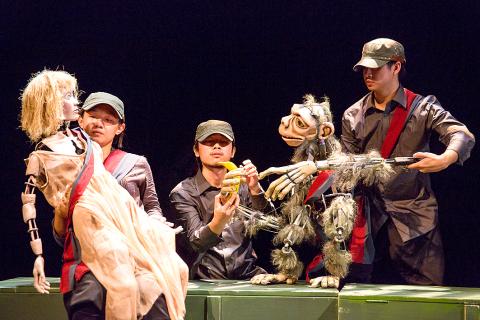In Hans Christian Andersen’s The Red Shoes, the girl is ostensibly condemned for her vanity and ordered to dance forever.
But Lin Meng-huan (林孟寰), director of the Puppet and Its Double Theater (無獨有偶工作室劇團), isn’t buying it. He thinks the girl was punished for daring to defy state-sanctioned morality and unjust rules.
The idea for a contemporary update of the 19th-century tale came a few years ago when the Arab Spring surprised the world, and just when the ongoing struggles for land justice were gaining momentum.

Photo courtesy of Puppet and Its Double Theater
“It got me to start thinking how an individual fights against the state apparatus. To me, the red shoes are not a curse. Rather, they encourage the girl to pursue freedom and what she think is right,” Lin told the Taipei Times.
Lin’s reflections led to his version of The Red Shoes, a collaboration between his contemporary puppet theater and In Tap (音踏), a tap dance group noted for collaborating with artists from different fields.
It is performed by a group of puppeteers “who are really interested in tap dancing.” says Lin, who writes and directs the play.

Photo courtesy of Puppet and Its Double Theater
Without uttering a word, five performers — including veteran tap dancer Chou Chun-peng (周浚鵬) — click across the stage, manipulating puppets to tell a rather dark story about a girl using her body to rebel against her oppressors. The performance is choreographed to live music by Lei Sheng (雷昇), who plays a melodica (a flute affixed with a keyboard) as well as electric and acoustic guitars on stage. The versatile musician also composes the pre-recorded music for the work, mixing historical recordings of talks by Chiang Kai-shek (蔣介石) and other dictators from human history.
The creations by puppet designer Liang Meng-han (粱夢涵) are mostly crude and skeletal figures suitable more for conveying emotions than for depicting realistic actions.
Also, the structures of the string puppets don’t try to conceal the relationship between puppet and puppeteer.
“Audiences can clearly see how the puppets are manipulated by the performers. To me, it is a magical moment to witness inert puppets coming to life,” the director explains.
The marriage of puppetry and tap dance, however, poses a challenge to even the most veteran of artists on both sides.
“Puppetry is somewhat similar to modern dance because both arts pay attention to fluidity and body rhythm. Tap dance, on the other hand, gets its rhythm mostly from the feet … For inexperienced dancers, their bodies tend to be stiff, and their attention is all on the steps,” Lin notes.
Since both puppetry and tap dance require years of training to master, Lin believes The Red Shoes is only the beginning of an exciting marriage between the two art forms.
“As the performers have gotten more and more relaxed, the two very different bodies have gradually grown to accept each other,” the director says.

April 14 to April 20 In March 1947, Sising Katadrepan urged the government to drop the “high mountain people” (高山族) designation for Indigenous Taiwanese and refer to them as “Taiwan people” (台灣族). He considered the term derogatory, arguing that it made them sound like animals. The Taiwan Provincial Government agreed to stop using the term, stating that Indigenous Taiwanese suffered all sorts of discrimination and oppression under the Japanese and were forced to live in the mountains as outsiders to society. Now, under the new regime, they would be seen as equals, thus they should be henceforth

Last week, the the National Immigration Agency (NIA) told the legislature that more than 10,000 naturalized Taiwanese citizens from the People’s Republic of China (PRC) risked having their citizenship revoked if they failed to provide proof that they had renounced their Chinese household registration within the next three months. Renunciation is required under the Act Governing Relations Between the People of the Taiwan Area and the Mainland Area (臺灣地區與大陸地區人民關係條例), as amended in 2004, though it was only a legal requirement after 2000. Prior to that, it had been only an administrative requirement since the Nationality Act (國籍法) was established in

With over 80 works on display, this is Louise Bourgeois’ first solo show in Taiwan. Visitors are invited to traverse her world of love and hate, vengeance and acceptance, trauma and reconciliation. Dominating the entrance, the nine-foot-tall Crouching Spider (2003) greets visitors. The creature looms behind the glass facade, symbolic protector and gatekeeper to the intimate journey ahead. Bourgeois, best known for her giant spider sculptures, is one of the most influential artist of the twentieth century. Blending vulnerability and defiance through themes of sexuality, trauma and identity, her work reshaped the landscape of contemporary art with fearless honesty. “People are influenced by

Three big changes have transformed the landscape of Taiwan’s local patronage factions: Increasing Democratic Progressive Party (DPP) involvement, rising new factions and the Chinese Nationalist Party’s (KMT) significantly weakened control. GREEN FACTIONS It is said that “south of the Zhuoshui River (濁水溪), there is no blue-green divide,” meaning that from Yunlin County south there is no difference between KMT and DPP politicians. This is not always true, but there is more than a grain of truth to it. Traditionally, DPP factions are viewed as national entities, with their primary function to secure plum positions in the party and government. This is not unusual